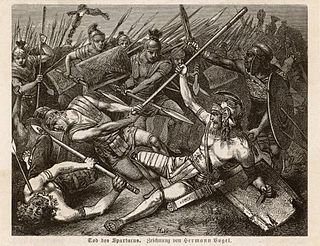
A slave rebellion is an armed uprising by slaves, as a way of fighting for their freedom. Rebellions of slaves have occurred in nearly all societies that practice slavery or have practiced slavery in the past. A desire for freedom and the dream of successful rebellion is often the greatest object of song, art, and culture amongst the enslaved population. These events, however, are often violently opposed and suppressed by slaveholders.

William Thomas Beckford was an English novelist, art critic, planter and politician. He was reputed at one stage to be England's richest commoner.

The Baptist War, also known as the Sam Sharp Rebellion, the Christmas Rebellion, the Christmas Uprising and the Great Jamaican Slave Revolt of 1831–32, was an eleven-day rebellion that started on 25 December 1831 and involved up to 60,000 of the 300,000 slaves in the Colony of Jamaica. The uprising was led by a black Baptist deacon, Samuel Sharpe, and waged largely by his followers. The revolt, though militarily unsuccessful, played a major part in the abolition of slavery throughout the British Empire.

Accompong is a historical Maroon village located in the hills of St. Elizabeth Parish on the island of Jamaica. It is located in Cockpit Country, where Jamaican Maroons and Indigenous Taíno established a fortified stronghold in the hilly terrain in the 17th century. They defended it and maintained independence from the Spanish and then later the British, after the colony changed hands.

Westmoreland is the westernmost parish in Jamaica, located on the south side of the island. It is situated south of Hanover, southwest of Saint James, and northwest of Saint Elizabeth, in the county of Cornwall. The chief town and capital is Savanna-la-Mar. Negril, a famous tourist destination, is also situated in the parish.
Edward Long was a British judge and historian best known for writing a book about the history of Jamaica in 1774 that was heavily rooted in proslavery thought.

Tacky's Revolt was a slave rebellion in the British colony of Jamaica which lasted from 7 April 1760 to 1761. Spearheaded by self-emancipated Coromantee people, the rebels were led by a Fante royal named Tacky. It was the most significant slave rebellion in the West Indies between the 1733 slave insurrection on St. John and the 1791 Haitian Revolution. The rebels were eventually defeated after British colonial forces, assisted by Jamaican Maroons, waged a gruelling counterinsurgency campaign. According to historian Trevor Burnard, "[in] terms of its shock to the imperial system, only the American Revolution surpassed Tacky's War in the eighteenth century." It was also the largest slave rebellion in the British West Indies until the Baptist War of 1831, which also occurred in Jamaica.

William Beckford of Somerley was a Jamaican-born planter and writer who wrote on the topography and conditions of slavery in the British colony of Jamaica and the history of France.

Peter Beckford was a Jamaican planter, politician and merchant who served as speaker of the House of Assembly of Jamaica from 1707 to 1713, and again in 1716. The son of one of the richest men in the colony of Jamaica, Beckford sat in the House of Assembly of Jamaica for three decades and acquired a vast financial estate. His wealth would go on to support the political careers of his children in Great Britain.
Jamaican Maroons descend from Africans who freed themselves from slavery in the Colony of Jamaica and established communities of free black people in the island's mountainous interior, primarily in the eastern parishes. Africans who were enslaved during Spanish rule over Jamaica (1493–1655) may have been the first to develop such refugee communities.

Sir Peter Beckford was a British writer and politician who represented Morpeth in the House of Commons of Great Britain from 1768 to 1774. He was also a patron of classical composer and pianist Muzio Clementi. A prominent member of the fox hunting community in England, he owned a pack of hunting dogs and wrote the work Thoughts upon Hunting (1781) which served as a guide to the practise.
Vincent Brown is Charles Warren Professor of History, Professor of African and African-American Studies, and Director of the History Design Studio at Harvard University. His research, writing, teaching, and other creative endeavors are focused on the political dimensions of cultural practice in the African Diaspora, with a particular emphasis on the early modern Atlantic world.

Arthur Forrest was a Royal Navy officer and planter who saw service during the War of the Austrian Succession and the Seven Years' War, rising to the rank of captain and the post of commodore. He also owned 3,000 acres of sugar plantations, and a considerable number of slaves, in the Colony of Jamaica.

The Crown Colony of Jamaica and Dependencies was a British colony from 1655, when it was captured by the English Protectorate from the Spanish Empire. Jamaica became a British colony from 1707 and a Crown colony in 1866. The Colony was primarily used for sugarcane production, and experienced many slave rebellions over the course of British rule. Jamaica was granted independence in 1962.
Joseph Foster Barham, the younger was an English politician, merchant and plantation owner.

Nathaniel Bayly was an English planter and politician who sat in the House of Commons from 1770 to 1779.
Zachary Bayly (1721-1769) was an English-born Jamaican planter and politician.
Free black people in Jamaica fell into two categories. Some secured their freedom officially, and lived within the slave communities of the Colony of Jamaica. Others ran away from slavery, and formed independent communities in the forested mountains of the interior. This latter group included the Jamaican Maroons, and subsequent fugitives from the sugar and coffee plantations of coastal Jamaica.
Richard Beckford was an English Whig politician.

The Beckford family was an aristocratic English family in Jamaica. They were known for their involvement in the slave trade and owning plantations in the West Indies in the 17th century.















